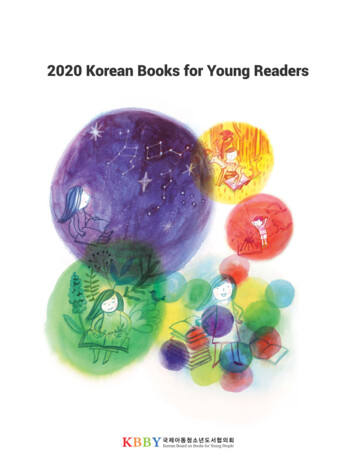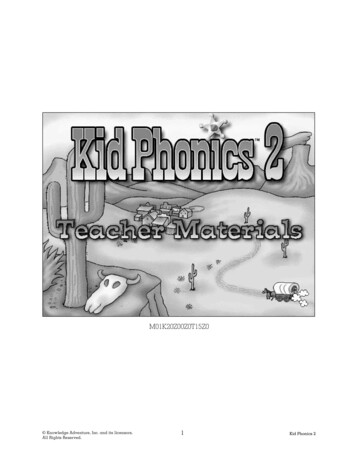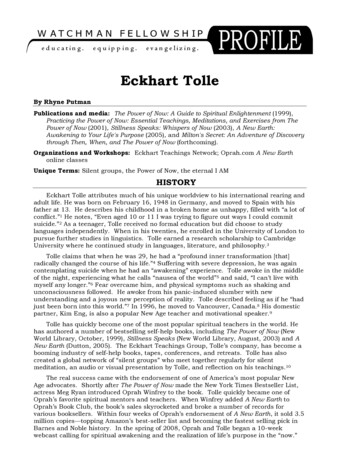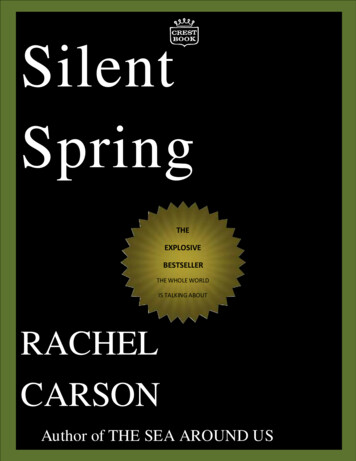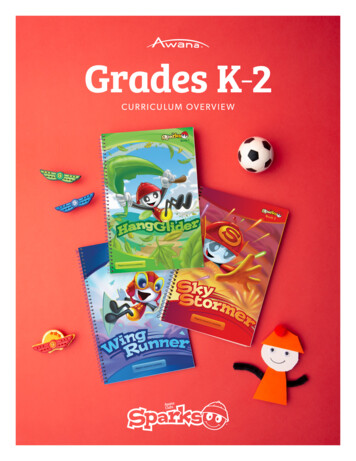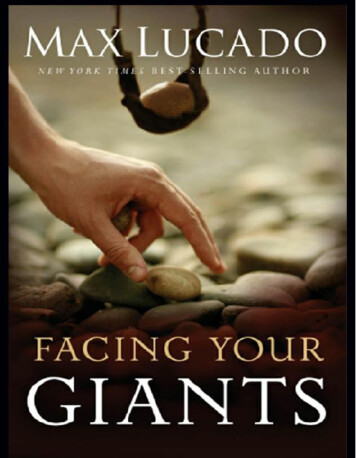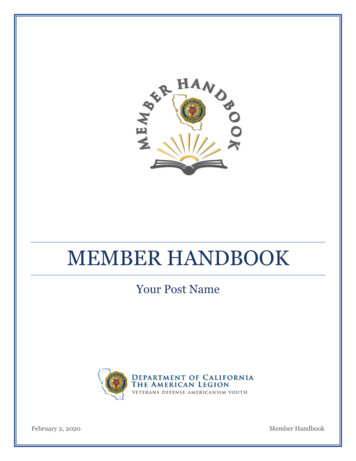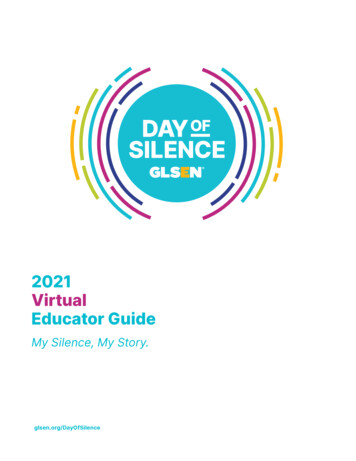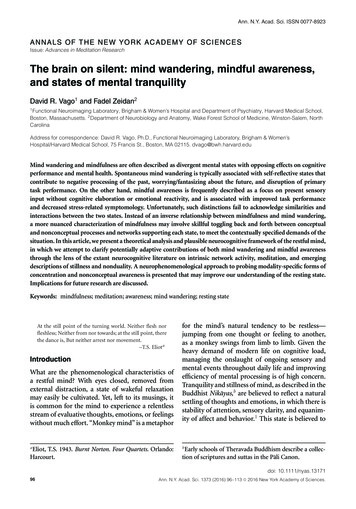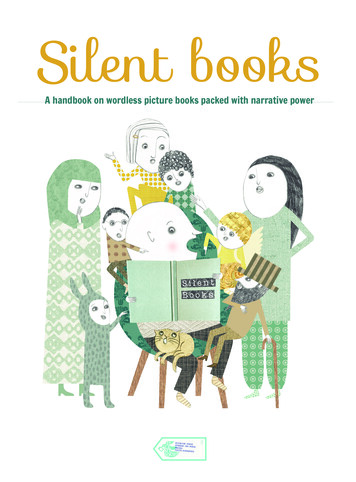
Transcription
Silent booksA handbook on wordless picture books packed with narrative power
Published by IBBY Sweden with the support of the Swedish Arts Council.Thanks are also due to the Swedish Institute for Children’s Books and the Swedish Library AssociationText: Rose-Marie LindforsIllustrations: Kristina AlfonsdotterGraphic design and production: Jonas Lundqvist information ABISBN 978-91-639-0685-5 author and IBBY SwedenThe book may be copied and used in educational work, but not for commercial purposes – not to be copied and sold onPrinting: GTC Print, Luleå, March 2016
ContentsForewordpage 2Introduction to IBBY and the Silent Books initiative.Why Silent Books?page 3The refugee situation and the reception that prompted new solutions,providing something to look forward to, something to long for, and thatsent ripples across other countries.Encounters with Silent Bookspage 4Mariella Bertelli, librarian and storyteller, with experience fromLampedusa and coordinator of the IBBY International Silent BooksExhibit Tour in Canada, explains the approach.Discover and discusspage 5On the possibilities of wordless books.Imagine and dreampage 6On the power of the imagination and how important it is to all of us.Storytellingpage 7A historical and traditional pastime.Good examples and practical tipsOn what you can do with Silent Books.Literature tipspage 16List of Silent Books.IBBY Swedenpage 16What role does IBBY Sweden play?Contactspage 161page 11
“.the inherent narrativepower of the imagescan bridge cultural andlinguistic barriers”Silent Books SwedenLiterature project at public libraries and refugee centresIn 2012, IBBY Italy launched a project called: “Silent Books: from the world toLampedusa and back”. The project focused on a collection of wordless picturebooks, on the understanding that the inherent narrative power of the images couldbridge cultural and linguistic barriers. Everyone could share in the same story, nomatter where they came from or what language they spoke.IBBY Sweden launched a Swedish variant of the project in autumn 2015.The aim is to develop methods of working with wordless books in collaborationwith public libraries and refugee centres. This book has been put together byRose-Marie Lindfors from Skellefteå as a source of support and inspiration.She has experience of both Silent Books and language teaching for immigrants.Rose-Marie is a drama teacher who uses storytelling as a method of languagedevelopment. A working group has also selected a range of wordless picturebooks that can work well in Sweden. The books have been sent to a number ofmunicipalities where the handbook is being tried out. A report will be writtenabout the experiences from these trials and this will be published on IBBYSweden’s website.IBBY Sweden hopes that the literature will help to promote communication andlanguage development for everyone involved, and to bring a joy of life and ofstorytelling to children, young people and adults alike.Ulla Hjorton, Chairperson IBBY SwedenCay Corneliuson, project manager Silent Books Sweden2
Why Silent Books?The refugee situation and the reception thatprompted new solutions, providing somethingto look forward to, something to long for, andthat sent ripples across other countries.It all began in Lampedusa, an island inThe books have no text, but theyare particularly rich in their visuallanguage, a language that everyonehas access to, and a language thatmakes it possible for us to dream andto imagine. Wordless books can tellsimple and linear tales or complexstories, and they push the boundariesof artistic and creative expression.southern Italy where many refugeeshave been arriving after long and hazardous boat journeys across the Mediterranean Sea. The people coming herecarried with them fear, anxiety, griefand longing. The situation created theconditions for a new means of refugeereception.unforgettablemeetings betweenpeople, books andstories”Librarians, volunteers from aroundthe world and the local islandersset up reading sessions that becameunforgettable meetings between people,books and stories.It soon became clear that the booksand the stories gave comfort andsecurity, an opportunity to disappearinto a story and escape the difficultiesof life for a moment. This was a placewhere people could share worlds andexperiences with each other. The booksprovided a fast route into the newlanguage, and sparked a desire to read.In Lampedusa, wordless books packedwith pictures and stories were selected in a project called “Silent Books”,and it was so successful that it is nowbeing spread all over the world viaIBBY. They are reaching out to peoplefrom all cultures, irrespective of whichlanguage they speak.3
”The wordless books generatean interest in exploring what astory can beEncounters with Silent BooksA few reflections from Mariella Bertelli, librarian and storyteller, with experiencefrom Lampedusa and coordinator of the IBBY International Silent Books ExhibitTour in Canada:The wordless books generate an interest in exploring what a story can be.I discovered that the stories can: tell a tale with a beginning, a middle and an end be playful and open the way for games, improvisation and guessing prompt discussions about diversity, differences and new perspectives throw up new words, sentences, associations pave the way for imaginative journeys inspire interpretations and discussions about art and illustrationsThe quiet feeds the mind and creates presence – a tip on how you might get started:Choose a book, sit together (2 people or 20), show each page – you don’t need to sayanything. Be open to what the participants say, let them say what they need to say.You’ll be surprised by the presence and concentration that can occur. When the book isfinished, ask for a word that sums up the book.Sometimes the session leaves behind a sense of peace and calm, while also being concrete and anchored in the experience.4
Discover and discussOn the possibilities of wordless books.Welcome on a journey of discovery throughmany different visual worlds. Bookswithout words draw readers in via thepictures, and then we can start creatingthe stories. The books offer so manyopportunities to be read.“Look, the girl’s drawing a red door, andnow she’s going through it, she’s steppinginto a world full of life,” says a youngwoman who is encountering the bookJourney for the first time. For her, thewordless books offer a way to find moreroutes into the new language. But thisalso offers an opportunity to dream andto imagine. “Imagination and dreaminggive me strength as I wait to find outwhether or not I can stay,” she says.As language teachers, we need to becurious about and interested in thepictures and stories in the books. Whenpractising the language, it is important tobegin with something you share, withpictures that talk about a reality you canput into words together. Repeat the words,repeat the sentences, place the words inthe contexts provided by the book.Begin with the concrete and then progressto imagining and heading off on a newadventure. Encourage associations andpersonal creativity. Note: Be aware thatthe children may have had traumaticexperiences, and think about how thesecan be handled when choosing a book!5The book Flotsam explores what is inand by the water. Everyone has different experiences and memories of water: sunny, fun, sad, painful. The storycan be read in small or large groups.The book is a source of inspirationfor personal creativity using variousmaterials.Questions to open with:What can you see in the pictures?Share your experiences of being on abeach.Continue asking questions based on whatyou can see and put words to everything.Repeat.When the film in the camera is developed,what happens?This can prompt guesses, dreams,playfulness and associations.Who might that be, sitting on the othershore?What’s happening now? Create brand newjourneys, to new places in the world.
Imagine and dreamOn the power of the imagination and how important it is to all of us“During the long walk, when none of us knew what was on the other side of themountain, when I was freezing cold and the food had gone. Then there weremoments when I imagined I was on my way to a country where no bombs fall,where there is a place for me, where there is food for everyone, where I could livea good life, in a warm house, where my children could be born.”Young person, seeking asylum in Sweden“. moments when Iimagined I was onmy way to a countrywhere no bombs fall.Our capacity to imagine and dream about a future meansthat we can picture what we don’t yet know. This givesus the strength to cope, to take courage and to trust thateverything can be better.Everyone shares the capacity to imagine, and it grows outof our experiences, drawing nourishment from the reality ofour lives.6
“Our brains aredesigned to create andto take in stories”StorytellingA historical and traditional pastimeStorytelling is something we share with all of humankind across the globe.Our brains are hard-wired to create and to take in stories.It is our way of sharing experiences, preserving our history and explainingthe world. Storytelling is therefore a successful way to meet across culturalboundaries, and to work on diversity and inclusion.Everyone has a story to tell, everyone can take part.Oral storytelling. creates common ground between people of all ages with different backgrounds,abilities or interests develops language, vocabulary and the ability to understand each other strengthens our ability to listen and to speak helps us to think and to remember creates motivation and a desire to read and write develops social skills, strengthens identity and self-esteem7
StoriesStories have always been part of us. It began with the oral tradition,dancing and singing. Then we created cave paintings and everythingmigrated onwards from generation to generation. Now we live in a worldfilled with books, images, films, theatre, dance, YouTube, Facebook andso on, and we continue the storytelling.Stories give us answers about what it is to be human. We can sharememories and experiences, create ideas about the societies we want tolive in, things we dream about and long for.Whether the stories are verbal or on the page, we use the words,the rhythm and our empathy to paint pictures of environments,people and events.The storyteller or author makes it possible for the listener to create theirown understanding, to play the film in their head.The person doing the storytelling uses their own language to convey thestory. The storyteller is the instrument of the story.“Stories give usanswers aboutwhat it is to behuman”8
Storytelling tipsSometimes you need a warm-up to ease you into the books and the stories. Here area few tips on various exercises that make it easier for the storytelling to getstarted. It is important for everyone to train up their ability to express themselves.From four questions – storytelling together(2 or more people)Since no one knows what this story will be, you can openly and inquisitively put questionsto each participant, making it possible for everyone to answer and so make theircontribution to the story.Start with:1: One upon a time . Who is the story going to be about?Where did that person live, and with whom?2: Every day . What was done every day?3: But one day . What happened?4: So today What is going on today?What was the story in the end? Retell it.Let your imagination flyThe group sits in a circle, and the person who starts (no. 1) says to their neighbour (no. 2)“you don’t know what I have in my pocket”. The neighbour replies “Yes I do, you have a .”The answer is based on a theme, which in this case is “enormous things”.So the neighbour comes up with something enormous that would really not be found inanyone’s pockets usually.No. 1 then answers: “That’s right, and I have it because .”This leads to many fun stories that encourage joking and laughter.The theme can easily be changed: Things that live in the sea. Things that can fly in the air.Things that are found in the forest, etc.9
AssociationsWhoever starts has a word and a ball. The word and theball are thrown to the next person, who catches the ball,repeats the word and then chooses a new word (which isthe first word they think of) and then throws the ball on tosomeone else, and so on.This throws up many new words, as laughter bouncesaround the room.The photo that tells a storyLay the photos out on a table. Ask the participants to go around and look at the photos,and then choose one they like. Then everyone gets to talk about their own picture andlisten to each other.The exercise encourages people to express themselves, generating long stories based ontheir own experiences, places they have been to, and their own life story.The object that tells a storyFill a suitcase with various different objects that belong in different places and in differentenvironments. Begin by naming them. Use the objects as triggers to create stories bothfrom reality and the imagination.1: Choose an object that reminds you of an incident from childhood, tell the story.2: Created a fictional story in which the object plays a key role, tell the story.3: Tell the group a memory from a house you once lived in. Choose an object that looksinteresting and give it a meaning in your story that is based on your imagination.Mix up fact and fantasy.10
Good examples andpractical tipsOn what you can do with Silent BooksThis can easily be linked to the migrants’ ownexperiences of coming from one world and suddenlybeing invited into someone else’s world. How canyou understand the world you’ve ended up in?With whom can you share the experiences andquestions that arise? Which of the worlds do youbelong to?Start by talking together about what is happening ineach picture.THE SNOWMANby Raymond BriggsAbout a boy who makes asnowman that comes to life.One night the boy invitesthe Snowman to experiencehis life indoors, completewith TV, lights, stove andballoons. They even go outin the car. The Snowmanthen introduces the boy tothe world outside, whichis filled with snow, air andopportunities to fly.What are the participants’ experiences of snow andwinter?Talk about all the new things the Snowmandiscovers.Talk about all the new things the boy discovers.What happens at the end?Start from the beginning of the book, go frompicture to picture and let the adults retell the story.Invite the participants to shout “Stop, I was there”,and then the person who shouts gets to tell thestory as if they were really there. Using their imagination, they explain what it was like being in thatparticular picture. Encourage them to use all theirsenses in the description. What could you hear?What could you feel in the air? What could yousmell?What could you see, that isn’t in the picture?What about taste? Balance?Give it plenty of time, let many voices be heard, leteveryone get involved in fleshing out to the story.11
“Can lead to discussionsabout longing and dreams.Read the book together. Recount what you cansee together.Questions to ask:What does the child want, do you think?What happens when the red crayon is found?Who has the purple crayon?What happens next?JOURNEY by Aaron BeckerWhere does the journey take us?About a lonely person whofights to be seen and listenedto and then, with the helpof a red crayon and someimagination, moves on,finding tricks to overcomedifficulties, and who eventually finds a friend whohas also discovered a magiccrayon and a capacity forimagination.What can you see?A book about the mostimportant thing we have,our imagination, which cantake us far and carry us overlife’s hurdles. A hopeful taleof survival, of finding newpaths when the old ones areclosed.What do you think about it?Populate the place, who lives there?What’s happening? What does the child see?What do you think the child thinks about the birdin a cage?What happens next?How does it end?This can lead to discussions about longing anddreams, the power of the imagination, helpingand receiving help. It creates opportunities foreveryone to express themselves – verbally andthrough drama, images, music, dance, film andwriting. Ask at the library about inspiring bookson creativity.12
THE ARRIVAL by Shaun TanA man leaves his wife and child ina poor town, seeking somethingbetter in an unknown land on theother side of a large ocean. Hesoon finds himself in a confusingcity of strange customs, remarkable animals, curious floatingobjects and unreadable languages.With nothing but a suitcase anda handful of money, he must finda place to live, food to eat andsome form of work. He is helpedalong the way by sympatheticstrangers, each with their ownunspoken narrative: stories ofstruggle and survival in a worldof unfathomable violence, chaosand hope.A book about the migrationin the world, then, now and inthe future. A story about thecommon problems that refugeeshave, whatever their nationality.It is about language, about beingunderstood and understanding,about homesickness, poverty andseparation from your family.As the story is being told, you have an opportunity to imagine what it might be like to livelife as a stranger in a new land. It opens upa chance to explore what it would be like tocome to a new country as a foreigner. Whatwould you do to achieve a sense of belonging?Where would you find contexts to become partof?Tell the story the way you think it wants to betold.How does the story begin?Who is it about?What is happening?What do you think each person in the familythinks about it?What is the threat?Where does the father go in the boat?What is the boat journey like?Is there any sense of longing, loss, grief in thestory?Where does he end up?What happens in the new town?What happens next?Who is the animal-like being who seeks afriendship with the man?What is it trying to tell us?The story is best told orally, or performed astheatre. Write texts to accompany the story,perhaps poetry or some other literary genre.Book tip: Skriv om och om igen (Write and rewrite), Katarina Kuick and Ylva Karlsson.Dramabok (Drama book), Hägglund/Fredin.13
“Create yourown picturesof places youhave lived”MIRROR by Jeannie BakerMeet two families who livein very different worlds,one in Australia, one inMorocco. Their lives appearto be so very different, butthere are many things thatconnect them.The book reflects thesedifferences and similarities.It shows that, no matterwhere we live in the world,most things in life are quitesimilar.Enable the participants to talk about their ownbackground, their everyday life, celebrations,school, relatives, friends and everything else thatmakes up our lives.What other worlds might we share? What otherpictures of everyday life might we share?Create your own pictures of places you havelived.Say more on the theme “this is where I am inSweden today” in pictures, text and oral stories.Find inspiration for your own pictorial creativityand collages at: pa-egen-hand/Materialtips-/We need our family, wewant to be loved and tobelong. We need to sleep,eat, work, shop and helpeach other. We are all partof a big world where we canshare experiences, memories, places and dreams.14
THE LION AND THE MOUSEby Jerry PinkneyMeet one of Aesop’s famousfables, now exclusively inpictures, so that the oldtale can once again be toldorally. The little mouse isfleeing for its life and runsstraight into the lion, but thelion chooses to let the mouselive. Later hunters capturethe lion in a rope net. Nowit’s the mouse’s turn to helpthe lion.What other fables and legends have been handeddown as cultural treasures? Which ones do youknow?How can you find more? What can you search forin books or on the internet?What are the stories trying to tell us? Are thereany proverbs or sayings that describe the contentof the story?Tell each other, create environments where youcan easily share the old stories with each other.Book tip: Aesop’s Fables by Piet Grobler/BeverleyNaidoo.Begin by looking at the pictures.Talk together about who you can see in thepicture.What time of year is it? What is the weather like?To give the words meaning, you can start creatinga story “Once upon a time.” based on the wordsprovided by the participants. The story will probably be about a bear who encounters a tree wherethere is a house But what happens next?THE TREE HOUSEby Marije & Ronald TolmanExplore every angle based on your senses: whatcan you see, hear, feel, smell and what tastes arethere in the pictures? What encounters occur inthe pictures, what happens then?The book carries us off to abig tree and a little house.15
Book list Silent BooksPUBLISHED IN SWEDEN:PUBLISHED IN OTHER COUNTRIES:Andersson, Lena: Kanin-paket(Rabén&Sjögren)Baker, Jeannie: Mirror (Australia)Banyai, Istvan: Zoom (USA)Becker, Aaron: Journey (ABC förlag)Berner, Rotraut Susanne: The Winter BookBriggs, Raymond: The Snowman(B. Wahlströms)Handford, Martin: Where’s Waldo? (USA,original UK)Drews, Judith: Stockholm – Vimmelboken(Lilla Piratförlaget)Pinkney, Jerry: The Lion & the Mouse (USA)Forslind, Ann: Bäbis kär (Alfabeta)Tolman, Marije & Ronald: The Tree House(USA, original Netherlands)Tan, Shaun: The Arrival (Kabusa)Tjong-Khing, Thé: Where is the cake?(En bok för alla)Wiesner, David: Flotsam (USA)IBBY SwedenIBBY Sweden works to raise awareness of Swedish children’s literature abroad and to introduce foreign children’s literature into Sweden through IBBY’s network in over 70 countries.IBBY Sweden is open to EVERYONE who is interested in literature for children and young people and who wishes to support IBBY’s core objectives: to let children’s books build bridgesbetween people and to ensure that children all over the world have access to books.Our mission includes: promoting intercultural understanding through children’s literature promoting children’s access to literature of high literary and artistic quality promoting the publication and distribution of children’s literature – particularly indeveloping countries promoting the education and training of those who work in children’s literature promoting research and academic work in the field of children’s literatureContactsCay Corneliuson, project manager Silent Books Sweden:corneliuson@hotmail.com, tel 46 (0)733 604 691Rose-Marie Lindfors, RM Utveckling, drama teacher and author of the handbook:rm.lindfors@gmail.com, tel 46 (0)70 649 44 3916
The boundless possibilitiesof wordless booksThis book was written by drama teacher Rose-Marie Lindfors forthe Silent Books project in Sweden, based on a selection of wordlesspicture books chosen by IBBY Sweden. The aim is to provideinspiration and guidance for everyone who wants to try using SilentBooks to prompt discussions with children and young people.The idea originally comes from IBBY in Lampedusa, where there aremany children and young people with different linguistic backgroundsfleeing from war and oppression. The handbook and the selectionof books are being trialled in collaboration with public libraries andasylum centres in around 10 Swedish municipalities. Mariella Bertelli,a librarian and storyteller with experience from Lampedusa, describesSilent Books as follows:The barrier-free nature of these wordless books – outside of language,culture, age and intellectual ability – adds a totally democraticelement to the reading experience. This fundamentalconcept goes hand in hand with IBBY’s missionthat it is through children’s books that we cancreate more tolerance and understanding amongthe people of the world.Cay Corneliuson, project manager IBBY Swedenwww.ibby.se
Silent Books Sweden Literature project at public libraries and refugee centres In 2012, IBBY Italy launched a project called: "Silent Books: from the world to Lampedusa and back". The project focused on a collection of wordless picture books, on the understanding that the inherent narrative power of the images could
